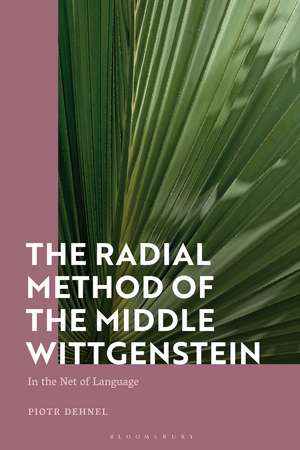The Radial Method of the Middle Wittgenstein: In the Net of Language
Autor Piotr Dehnelen Limba Engleză Paperback – 26 iun 2024
| Toate formatele și edițiile | Preț | Express |
|---|---|---|
| Paperback (1) | 191.22 lei 6-8 săpt. | |
| Bloomsbury Publishing – 26 iun 2024 | 191.22 lei 6-8 săpt. | |
| Hardback (1) | 510.34 lei 6-8 săpt. | +109.23 lei 4-10 zile |
| Bloomsbury Publishing – 14 dec 2022 | 510.34 lei 6-8 săpt. | +109.23 lei 4-10 zile |
Preț: 191.22 lei
Preț vechi: 249.30 lei
-23% Nou
Puncte Express: 287
Preț estimativ în valută:
36.59€ • 37.80$ • 30.46£
36.59€ • 37.80$ • 30.46£
Carte tipărită la comandă
Livrare economică 25 martie-08 aprilie
Preluare comenzi: 021 569.72.76
Specificații
ISBN-13: 9781350257375
ISBN-10: 1350257370
Pagini: 232
Dimensiuni: 156 x 234 x 25 mm
Greutate: 0.33 kg
Editura: Bloomsbury Publishing
Colecția Bloomsbury Academic
Locul publicării:London, United Kingdom
ISBN-10: 1350257370
Pagini: 232
Dimensiuni: 156 x 234 x 25 mm
Greutate: 0.33 kg
Editura: Bloomsbury Publishing
Colecția Bloomsbury Academic
Locul publicării:London, United Kingdom
Caracteristici
Explores a period in Wittgenstein's philosophy often disregarded as transitional, which has received too little attention to date
Notă biografică
Piotr Dehnel is Professor of Philosophy at the University of Lower Silesia and the Eugeniusz Geppert Academy of Art and Design in Wroclaw, Poland.
Cuprins
Introduction1. The Phenomenological Turn2. Verification: 1929-19323. Wittgenstein's Critique of Frege in the Notes of 1929-19324. 'A Clever Man got Caught in this Net of Language': Wittgenstein's Attack on Set Theory5. The Big Typescript as a Work of the Middle Period6. P.S. Understanding, Expecting, Wishing7. Magic, Rituals and Philosophy: Wittgenstein on Frazer's The Golden Bough8. Wittgenstein as a Philosopher of CultureBibliographyIndex
Recenzii
The book sheds an interesting new light on interpretations of Ludwig Wittgenstein's philosophy as it offers one of the first explorations of his concepts between the Tractatus and the Philosophical Investigations. The author argues that, rather than developing in a linear sequence from insight to insight and from idea to idea, Wittgenstein's thought in the middle period expands radially, unfolding in several directions at the same time. A must-read for Wittgenstein researchers, the book is certainly of profound interest to humanities scholars and social scientists alike.
This book offers broad hermeneutic explanations of Wittgenstein's writings from 1929 to 1936. They are based on a thorough knowledge of the source material, which they place in the context of his thought and its philosophical environment. I am impressed with the scientific merit of the present work.
This book offers broad hermeneutic explanations of Wittgenstein's writings from 1929 to 1936. They are based on a thorough knowledge of the source material, which they place in the context of his thought and its philosophical environment. I am impressed with the scientific merit of the present work.
